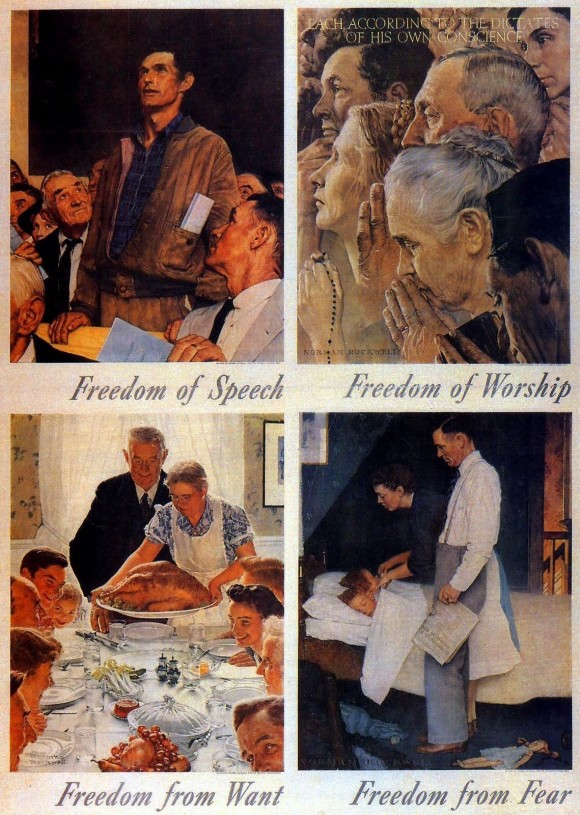
Roosevelt’s Four Freedoms’ Enduring Power
By William Shields, Staff Writer
In just a few weeks time, Americans will be partaking in a five-day Thanksgiving festivity, in several different forms, each of these traditions unique to a family. While family, food, and football are my first thoughts when Thanksgiving nears, every year, a series of Norman Rockwell paintings come to mind.
“The Four Freedoms” is a series of paintings created by Rockwell, the great American painter, for the cover of The Saturday Evening Post. Thanksgiving and Rockwell’s “Four Freedoms” are linked in my mind because of the happy and unifying feelings of America are inherent in both. “The Four Freedoms” shows the innate pleasure and camaraderie of family reunions at a holiday dinner. President Franklin D. Roosevelt inspired the series, during a speech in 1941 detailing the four rights that all people in the world deserved. Each of the four paintings by Rockwell depicted each of the freedoms listed in the Roosevelt speech including Freedom of Speech, Freedom of Worship, Freedom from Want, and Freedom From Fear. Roosevelt envisioned every person around the world having these rights. Which of these freedoms are actually protected for the American viewers of the paintings?
The rights to the first two freedoms listed, Speech and Worship, are more forthright. These rights are listed in the U.S. Constitution. Congress was prohibited from making any law or prohibition against any religion from the free exercise of speech or religious conviction. [1] These restrictions apply to the US Congress, thus making Freedom of Speech and Worship (or Religion) a nationwide right.
The right to the last two freedoms, Freedom from Want and from Fear, are more difficult to verify. The right to Freedom from Want is difficult to define. In his speech, President Roosevelt defined it as “economic understanding which will secure to every nation a healthy peacetime life for its inhabitants everywhere in the world.” [2] In Brotherhood of Maintenance of Way Emp. v. U.S., the U.S Supreme Court states that with technology, man can achieve “freedom from want, disease, and drudgery, and the consequent opportunity to lead human lives.” [3] These sources show that the freedom from want involves freedom from lack of the requirement for living a human life. This right could be understood as right to an adequate standard of living.
While there is no right in the Constitution protecting the right to freedom from want, the US has been instrumental in drafting and passing a United Nations (UN) declaration regarding the matter. The right to freedom from want, or the right to adequate standard of living is defined in the Universal Declaration of Human Rights (UDHR) as the right of a person to “the health and well-being of himself and of his family, including food, clothing, housing and medical care and necessary social services.” [4] As a signatory of the UDHR, the United States is bound to follow its provisions and articles. Therefore, a right to freedom from want does exist in the United States.
Lastly, the right to Freedom from Fear exists in the United States. In his speech, President Roosevelt defined freedom from fear as “a world-wide reduction of armaments to such a point and in such a thorough fashion that no nation will be in a position to commit an act of physical aggression against any neighbor.” [2] In the UDHR, freedom from fear is listed in the preamble. The UN General Assembly saw that “the advent of a world in which human beings shall enjoy freedom of speech and belief and freedom from fear and want has been proclaimed as the highest aspiration of the common people.” [5] The right to freedom from fear, while not listed in an article, was present in the declaration. In Roosevelt’s view of the term, the right to this freedom has been established. The protection of people from fear is protected in the UDHR and even in some individual jurisdictions in the US. [6] Therefore, the right to Freedom from Fear exists for American citizens.
While the rights of these freedoms are protected, the freedoms themselves are not active universally. There are still people who unnecessarily want and fear. While there are people with needs, many in the US have access to the “necessary social services” and their right to freedom is being protected.
During the seventy years since President Franklin Roosevelt’s “Four Freedoms” speech, the rights to the four freedoms have remained protected in the United States. The citizens in the United States have retained the rights to freedom of religion and speech, along with the rights of freedom from fear and from want The US of America continues its drive for freedom of its people.
[1] U.S. Const. amend. I.
[2] Franklin D. Roosevelt, President of the U.S., Annual Message to Congress on the State of the Union (January 6, 1941) available at http://www.fdrlibrary.marist.edu/pdfs/fftext.pdf.
[3] Brotherhood of Maintenance of Way Emp. v. U.S, 366 U.S. 169 (1961) (citing Dr. Robert M. Hutchins Two Faces of Federalism 24 (1961)).
[4] U.N. General Assembly, Universal Declaration of Human Rights art. 25, December 12, 1948.
[5] U.N. General Assembly, Universal Declaration of Human Rights pmbl, December 12, 1948
[6] State v. Oakes, 598 A.2d 119 (Vt. 1991); In re Zachary G., 982 A.2d 367 (N.H. 2009); Johnston v. Wallace, 53 Miss. 331 (1881); State v Adair, 596 P.2d 110 (Idaho 1979).